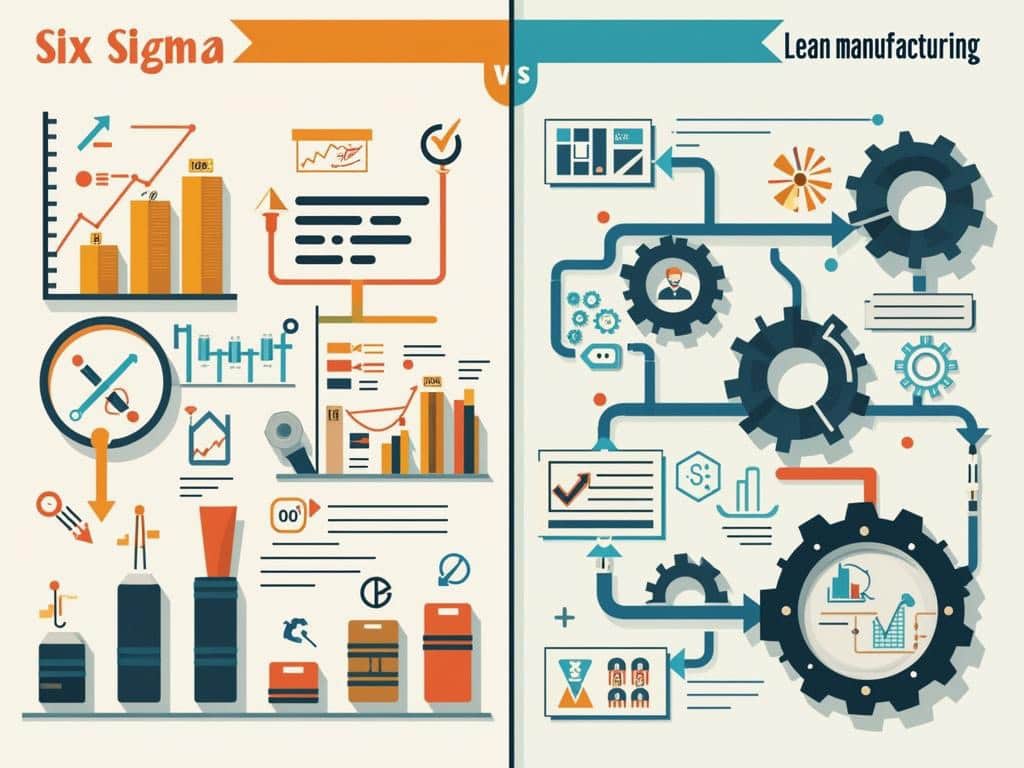
Understanding Six Sigma and Lean Manufacturing
Six Sigma and Lean Manufacturing stand as distinct yet complementary process improvement methodologies, each with unique approaches to organizational efficiency. Six Sigma reduces process variation through statistical analysis, targeting defects at 3.4 per million opportunities. In contrast, Lean Manufacturing focuses on eliminating waste and optimizing workflow using practical techniques from the Toyota Production System.
Key Takeaways
- Six Sigma uses data-driven statistical methods to reduce defects, whereas Lean Manufacturing emphasizes waste elimination and process flow.
- Both methodologies aim to improve organizational performance but employ different tools and approaches.
- Six Sigma relies on frameworks like DMAIC, while Lean uses techniques such as value stream mapping.
- Organizations can benefit from integrating both approaches into a Lean Six Sigma methodology.
- Successful implementation requires cultural transformation and comprehensive employee training.
These methodologies have transformed countless businesses across industries. Understanding their fundamental differences helps you select the right approach for your specific challenges. Many organizations find that combining Six Sigma’s analytical rigor with Lean’s practical waste reduction creates powerful results.
Implementation Journey
The implementation journey requires commitment at all organizational levels. Your team needs proper training in whichever methodology you choose. This investment pays dividends through improved processes, reduced costs, and enhanced customer satisfaction. Consider consulting with implementation specialists who can customize these approaches to your unique business needs.
“Six Sigma empowers organizations by harnessing data-driven statistical methods to minimize defects, while Lean Manufacturing excels at optimizing workflows through waste elimination. Together, they form a powerful synergy that drives organizational performance, underscoring the importance of cultural transformation and comprehensive employee training for successful implementation.”
Six Sigma: The Data-Driven Precision Methodology
Six Sigma represents a disciplined, data-driven approach to process improvement that focuses on reducing variability and eliminating defects. At its core, Six Sigma aims to achieve near perfection by limiting defects to just 3.4 per million opportunities. When considering what is the difference between Six Sigma and lean manufacturing, Six Sigma’s emphasis on statistical analysis stands out as a key differentiator.
The methodology revolves around two primary frameworks:
- DMAIC (Define, Measure, Analyze, Improve, Control) – Used for existing processes
- DMADV (Define, Measure, Analyze, Design, Verify) – Applied when creating new processes
Six Sigma practitioners progress through certification levels that indicate their expertise:
- Green Belt: Part-time project leaders
- Black Belt: Full-time improvement specialists
- Master Black Belt: Mentors who train others
- Champion: Executive sponsors who remove barriers
What is the difference between Six Sigma and lean manufacturing in terms of focus? Six Sigma concentrates on reducing process variation using statistical tools to identify and eliminate the root causes of defects. This contrasts with lean manufacturing’s emphasis on eliminating waste and improving flow.
General Electric’s implementation of Six Sigma famously saved the company hundreds of millions of dollars under Jack Welch’s leadership. Other organizations have achieved similar results by applying this rigorous methodology.
Key Statistical Tools in Six Sigma
Six Sigma practitioners rely on various statistical techniques to identify and solve problems. The following tools form the foundation of the what is the difference between Six Sigma and lean manufacturing approach:
- Statistical Process Control (SPC) charts
- Hypothesis testing
- Regression analysis
- Design of Experiments (DOE)
- Failure Mode and Effects Analysis (FMEA)
- Capability studies (Cp, Cpk)
These tools enable organizations to make data-driven decisions rather than relying on intuition. By implementing Six Sigma black belt projects, companies can systematically reduce defects and improve process performance.
When examining what is the difference between Six Sigma and lean manufacturing methodologies, it’s worth noting that Six Sigma’s statistical rigor often requires more extensive training and a longer implementation timeline. However, this investment typically yields significant returns through defect reduction and quality improvements.
Six Sigma also emphasizes a structured approach to conducting root cause analysis, which helps organizations address the underlying issues rather than just treating symptoms. This deep analytical approach helps create sustainable improvements that lead to long-term competitive advantages.
Companies that implement Six Sigma can achieve reductions in process variation leading to an increase in customer satisfaction and a decrease in operational costs.
hbr.org
Lean Manufacturing: Eliminating Waste and Optimizing Flow
Lean Manufacturing evolved from the Toyota Production System (TPS) and focuses on creating maximum value while minimizing waste. You’ll find its primary goal differs significantly from Six Sigma when considering what is the difference between Six Sigma and Lean Manufacturing. While Six Sigma concentrates on reducing variation and defects through statistical analysis, Lean emphasizes workflow optimization and waste elimination.
The core philosophy of Lean Manufacturing revolves around identifying and eliminating eight types of waste (muda):
- Transportation – Unnecessary movement of materials
- Inventory – Excess products and materials
- Motion – Inefficient movement of people
- Waiting – Idle time between process steps
- Overproduction – Making more than needed
- Overprocessing – Adding more value than customers require
- Defects – Products requiring rework
- Skills – Underutilization of employee capabilities
Lean practitioners use several key tools to identify and eliminate these wastes. Value stream mapping helps you visualize the entire production process, identifying bottlenecks and continuous improvement opportunities. The 5S system (Sort, Set in order, Shine, Standardize, Sustain) creates organized workspaces that minimize motion waste and improve efficiency.
Comparing Lean and Six Sigma Approaches
Understanding what is the difference between Six Sigma and Lean Manufacturing requires examining their distinctive approaches. The following table highlights these key differences:
| Aspect | Lean Manufacturing | Six Sigma |
|---|---|---|
| Primary Focus | Waste elimination and flow | Defect reduction and variation |
| Approach | Primarily qualitative | Highly quantitative/statistical |
| Tools | Value stream mapping, 5S, Kanban | DMAIC, statistical analysis, DOE |
| Origin | Toyota Production System | Motorola and General Electric |
| Main Objective | Reduce cycle times and improve flow | Achieve 3.4 defects per million |
| Implementation | Shop floor focused | Project-based approach |
Lean Manufacturing offers significant benefits including reduced cycle times, decreased inventory costs, and improved customer responsiveness. Unlike Six Sigma’s heavy reliance on statistics, Lean takes a more pragmatic approach, making it accessible for teams without extensive statistical training. This accessibility has made Lean principles increasingly popular in project management software implementations.
What is the difference between Six Sigma and Lean Manufacturing when it comes to results? Lean typically delivers faster initial improvements in operational efficiency, while Six Sigma provides more substantial long-term quality improvements. Many organizations now implement hybrid Lean Six Sigma approaches to capture the benefits of both methodologies.
Companies that implement Lean methodologies can achieve productivity improvements of 25% to 50%, while reducing waste by 30% to 70%.
forbes.com
Lean Six Sigma: A Comprehensive Approach to Process Excellence
Lean Six Sigma combines the strengths of both methodologies to create a powerful hybrid approach for organizations seeking comprehensive improvement. When you’re trying to understand what is the difference between Six Sigma and lean manufacturing, it’s helpful to see how they work together in this integrated methodology.
Six Sigma focuses primarily on reducing defects through statistical analysis and data-driven decision making. It aims to achieve 3.4 defects per million opportunities through the DMAIC (Define, Measure, Analyze, Improve, Control) framework. In contrast, lean manufacturing concentrates on eliminating waste and optimizing workflow, with roots in the Toyota Production System.
The hybrid Lean Six Sigma approach merges these complementary philosophies to deliver remarkable results. Organizations implementing this methodology have reported up to 80% reduction in lead times and 20% decrease in operational costs. What is the difference between Six Sigma and lean manufacturing becomes less important when you see how they complement each other – Six Sigma providing the analytical rigor while lean contributes the waste-elimination focus.
Key Benefits of the Integrated Approach
The Lean Six Sigma methodology offers several advantages over using either approach independently:
- Enhanced problem-solving capabilities through combining statistical tools with practical waste reduction techniques.
- More comprehensive process analysis addressing both variation and non-value-adding activities.
- Faster improvement cycles by applying lean principles to Six Sigma projects.
- Better employee engagement through varied improvement techniques that appeal to different thinking styles.
- Sustainable results through the integration of statistical control with a continuous improvement culture.
Companies like Lockheed Martin have demonstrated what is the difference between Six Sigma and lean manufacturing by implementing the integrated approach. They achieved significant improvements in production efficiency, quality metrics, and customer satisfaction.
| Aspect | Six Sigma | Lean Manufacturing | Lean Six Sigma |
|---|---|---|---|
| Primary Focus | Reducing variation and defects | Eliminating waste | Both defect reduction and waste elimination |
| Approach | Data-driven, statistical | Practical, observational | Balanced analytical and practical |
| Tools | Statistical analysis, DMAIC | Value stream mapping, 5S, Kanban | Comprehensive toolset from both methodologies |
| Speed | Sometimes slower due to analysis | Typically faster implementation | Optimized speed with appropriate analysis |
When implementing Lean Six Sigma, you’ll need to develop continuous improvement capabilities throughout your organization. The methodology requires both cultural transformation and technical training to be successful. By understanding what is the difference between Six Sigma and lean manufacturing, you can better leverage the strengths of each in your process optimization methods.
Expert Insight: To effectively implement Lean Six Sigma, prioritize the integration of statistical analysis with practical waste reduction techniques, ensuring a balanced approach to process improvement. Engage employees from various backgrounds by employing diverse improvement strategies that resonate with different thinking styles, fostering a culture of continuous improvement. Lastly, invest in training and cultural transformation to harness the full potential of this hybrid methodology and achieve sustainable results across your organization.
Implementing Lean Six Sigma in Your Organization
Implementing Lean Six Sigma requires a strategic approach that blends the best of both methodologies. Understanding what is the difference between Six Sigma and Lean manufacturing is crucial before you begin this journey. While Six Sigma focuses on reducing variation and defects through statistical analysis, Lean concentrates on eliminating waste and improving flow.
To successfully implement Lean Six Sigma, you’ll need to follow a structured approach. First, secure executive sponsorship to ensure necessary resources and organizational commitment. Top-level support creates the foundation for sustainable change and helps overcome resistance.
Next, assess your current state by analyzing existing processes to identify improvement opportunities. This step helps you understand what is the difference between Six Sigma and Lean manufacturing in practical terms within your specific operational context.
Implementation Steps for Success
When implementing Lean Six Sigma, consider these critical actions:
- Develop a clear implementation roadmap with specific milestones and timelines
- Select appropriate projects that align with strategic business objectives
- Build a skilled team through comprehensive Six Sigma Black Belt training and certification
- Establish relevant metrics to measure progress and success
- Create a communication plan to keep stakeholders informed
- Incorporate change management practices to address resistance
Cultural transformation is essential for Lean Six Sigma success. You must foster an environment where continuous improvement becomes part of everyday operations. This requires shifting from reactive problem-solving to proactive process optimization and continuous improvement thinking.
Training is another critical component. Develop a comprehensive program that includes awareness sessions for all employees and specialized training for those directly involved in improvement projects. Understanding what is the difference between Six Sigma and Lean manufacturing helps teams apply the right tools to the right problems.
| Aspect | Six Sigma | Lean Manufacturing | Lean Six Sigma |
|---|---|---|---|
| Focus | Reducing variation | Eliminating waste | Both variation and waste |
| Approach | Data-driven, statistical | Workflow optimization | Integrated methodology |
| Tools | DMAIC, statistical analysis | Value stream mapping, 5S | Combined toolset |
| Goal | 3.4 defects per million | Zero waste | Operational excellence |
Measurement systems must be established to track progress. Implement dashboards that monitor key performance indicators related to quality, cost, delivery, and customer satisfaction. Regular reviews help maintain momentum and identify areas needing additional support.
Potential challenges include resistance to change, resource constraints, and maintaining focus over time. Mitigate these by developing a strong communication strategy, securing adequate resources, and celebrating early wins to build momentum. What is the difference between Six Sigma and Lean manufacturing becomes less important than how they complement each other in addressing your organization’s specific needs.

Transformative Power of Integrated Process Improvement
Understanding what is the difference between Six Sigma and Lean Manufacturing helps you create a more effective operational strategy. Six Sigma focuses on reducing defects through statistical analysis, while Lean Manufacturing concentrates on eliminating waste and improving flow. When combined, these methodologies create a powerful framework for comprehensive process improvement.
The distinction between what is the difference between Six Sigma and Lean Manufacturing lies in their origins and approaches. Six Sigma emerged from Motorola and General Electric in the 1980s, focusing on reducing variability in processes to achieve near-perfect quality levels (3.4 defects per million opportunities). Lean Manufacturing evolved from Toyota’s Production System, emphasizing the elimination of waste and optimization of value streams.
Key Differences and Integration Benefits
Six Sigma and Lean Manufacturing differ in several important ways:
- Focus: Six Sigma targets defect reduction and process variation, while Lean concentrates on eliminating waste and improving flow.
- Approach: Six Sigma uses statistical tools and data analysis, whereas Lean employs visual management and practical waste reduction techniques.
- Implementation: Six Sigma follows the DMAIC (Define, Measure, Analyze, Improve, Control) methodology, while Lean uses tools like value stream mapping and 5S.
- Metrics: Six Sigma measures defects per million opportunities, while Lean tracks cycle time and inventory levels.
The integration of these methodologies into Lean Six Sigma creates substantial benefits for organizations. This approach can help you achieve up to 80% reduction in lead times and 20% cost reduction, according to Six Sigma implementation studies.
When implementing an integrated improvement approach, you’ll need to consider what is the difference between Six Sigma and Lean Manufacturing to leverage the strengths of each. This combined methodology addresses both process variation and waste elimination, creating a comprehensive approach to operational excellence.
Companies that successfully implement Lean Six Sigma, like Lockheed Martin, have experienced dramatic improvements in quality, productivity, and customer satisfaction. The continuous improvement mindset fostered by these methodologies transforms organizations by creating a culture focused on excellence.
What is the difference between Six Sigma and Lean Manufacturing becomes less important when you recognize how their integration provides a more holistic improvement framework. The statistical rigor of Six Sigma combined with the waste-elimination focus of Lean creates a powerful approach that drives better results than either methodology alone.






